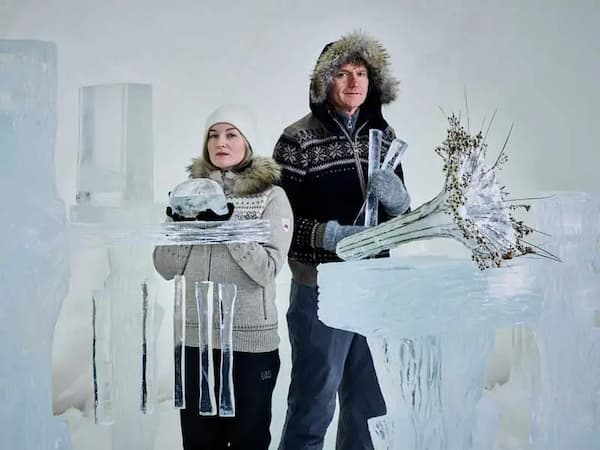Music featuring icy climates has always fascinated composers. Many composers are compelled by frozen tundra, the extremes of the poles, and frigid temperatures, and they have used polar backdrops as inspiration. Sergei Prokofiev’s Battle of the Ice from his work Alexander Nevsky is a portrayal of the thirteen-century prince who was able to repel the invading Swedes and Germans due to forging an alliance with Northern Russian Mongols. The Battle of the Ice depicts the 1242 battle where opposing forces were routed and trapped on the ice on the border between Russia and Estonia. Prokofiev begins with the strings playing on the bridge, ponticello and tremolo, for a decidedly chill and harsh atmosphere. There are ominous glissandos, swells of dynamics, and snarling trumpets. As the tempo increases, the snare drum and percussion dominate. Characteristic of Prokofiev, he juxtaposes the high instruments with the low. Once the battle is won, a delicate, lyrical theme enters in the violins, and the movement fades out into the atmosphere.
Sergei Prokofiev: Alexander Nevsky, Op. 78 – The Battle on the Ice (Czech Philharmonic Choir, Brno; Cologne Gürzenich Orchestra; Dmitri Kitayenko, cond.)
Norwegian traditional music often reflects the wintery north, such as one can hear on the album My Norwegian Winter.
Kome nord! (Ragnhild Hemsing, hardanger fiddle; Ole Aastad Bråten, langeleik; Knut Aastad Bråten, langeleik; Marthe Husum, viola; Frida Fredrikke Waaler Wærvågen, cello; Nikolai Matthews, double bass; Terje Isungset, percussion)
Nordic Soundscapes by contemporary Finnish Composer Outi Tarkiainen was featured at the Southbank Center in London this past fall. Born and raised in Lapland, she speaks eloquently about the crisis of losing the ice.
Nordic Soundscapes: Composer Outi Tarkiainen
Her Songs of the Ice is a fascinating work. It begins with exploding tam-tams like the percussion is attempting to imitate the ice breaking up and separating, but within a few minutes, the composer captures the silent chill of the atmosphere, then rare birds in delicate filigrees in the flute, piccolo, harp, and the shimmering strings. The opening disaster music returns, followed by a frantic outburst from the piccolo.
Outi Tarkiainen: Songs of the Ice (Finnish Radio Symphony Orchestra; Nicholas Collon, cond.)
Several cultures whose history of surviving and living with the elements in the Arctic have inspired definitive musical traditions. Those who endure frigid temperatures, and snow and ice, include the Finnish, Norwegians, Swedes, Inuit, Sámi, and Siberians whose longstanding respect for nature is reflected in their customs and their compositions.
Playing on ice instruments takes communing with the arctic further. How does one sculpt a fully playable upright bass made of ice I have to wonder?

Ice bass on the lake
Like any art, ice sculpting consists of many steps.
First, the ice must be harvested from a frozen tundra or river and chosen in large blocks. Apparently, the ice of each country has definitive characteristics. Next, the artisan will create a template or model to guide him or her. Specialised tools such as chainsaws, chisels, and gouges must be carefully used to carve the ice blocks. Then, the sculptor will smooth and refine using finer tools to remove rough edges, such as small chisels, knives, or even needles. A wood or fiberglass neck is attached to the ice body, then a fingerboard, perhaps even made of ebony—the traditional material used on string instruments, (but this wood is becoming endangered) or a synthetic ebony substitute. The tailpiece, a wooden bridge, and metal strings with tuning pegs that won’t damage the ice are the finishing touches.
Here is an example of an ice bass with a quite normal-looking scroll. Sculptor Tim Linhart from the documentary ‘The Voice of Water’ tells us about making his amazing ice orchestra in Luleå, Sweden.
The story about Ice Music in Swedish Lapland
The playability of the instrument depends on the smoothness of the surface of the instrument and if the dimensions adhere to the feel of an instrument made of wood, one we are accustomed to playing.
But how do they sound? You might ask. These instruments are cultivated for their ethereal and glass-like timbre. Many musicians and composers find the sound quite captivating. But an issue jeopardising the concerts had to be addressed. Ice instruments are sensitive to temperature fluctuations, especially if the ice starts to melt. When audience members enter the hall, their warm bodies and breathing raise the temperatures so that the strings on the string instruments might stretch, flattening or lowering the pitch, while the xylophone will go sharp. Here’s Linhart’s ingenious solution.
Coolest Concert Ever? Hear Ice Instruments Play Beautiful Music
Perhaps Norwegian composer and ice music pioneer Terje Isungset, one of Europe’s most accomplished and innovative percussionists, is best known for his decades-long Ice Music project and his role as All Ice Record label owner. Composer, drummer, associate professor of jazz, solo performer, and collaborator, with a lifetime of attempting to harness nature’s rhythmic forces, Terje pushes the boundaries of melodic structure and artistic expression. But more importantly, since 1999, after witnessing the devastating effects of global warming, he has worked with Greenpeace and others to highlight the dangers of ice loss and the need to protect our Arctic oceans.

To draw attention to this crisis, the Norwegian musicians staged a concert exposed to the elements. The goal—to raise awareness about climate change, and the need to protect the world’s oceans. Hailed as the first most northerly performance, the quartet played ‘Ocean Memories’ in temperatures below -12 degrees Celsius. Sculptor Bill Covitz of Ice Matter created an Iceophone, ice horn, and ice cello. What a sound!

Musicians play instruments in world’s most northerly ice music concert
Today, Isungset’s recordings comprise several albums of ice music, and they are riveting. To name a few, ‘Beauty of Winter’ – Ice Music Live from 2018, Glacial Poetry from 2022, and Arctic Ice Music. In “A glimpse of light” from that album, recorded at Grieg Concert Hall, the composer combines voice and traditional instruments with ice instruments.
Arctic Ice Music – 2018. Terje Isungset. “A glimpse of light”

A recent Ice Quartet recording features artists Julie Rokseth on Ice Harp, Toivo Fjose/Viktor Reuter on Ice Bass; Amalie Holt Kleive vocalist, electronics, ice percussion & water; and Terje Isungset playing the iceofone, ice percussion, ice horn & ice drum. Recorded inside an igloo in the Norwegian mountains(Bergsjøstølen), and during a tour of England, at concerts in Norway (Tyssedal Kraftmuseum) and in Hallibakken lydstudio in 2023 and 2024, the sobering lament and plea to save our arctic world are haunting.
Isungset has now produced his 18th Ice Music Festival in 2023. This is what he had to say, “Our international team of 26 people from 13 different countries worked for 8 days straight to create the festival. Battling against storm force blizzards and working long into cold nights, everyone inputted their skills – from ice extraction and venue design to audio-visual installs and ticketing.” Look at these enthralling photos and videos of this painstaking process.
Ice Music Festival 2023 website

ICE Festival photos by Isungset Bergerud
Now, are you tempted to make plans to attend next year, their 20th festival?
Ice castles and ice instruments and igloos oh my! Beautiful and crazy? The whole idea leaves me cold! So start the wisecracks. I can’t help repeating a few of them because as soon as musicians see a photo of the ice double bass, they let fly a barrage of facetious comments:

An ice bass
Gives me the chills.
He’s playing cool jazz.
You tune it to the thermostat.
Wait until he gets warmed up and plays the really hot parts.
How can you get a warm tone out of that?
In the spring it becomes a viola!
Seriously though please cool it!
Quips aside, Terje Isungset’s performances take place in his snug igloos, and they are mesmerising and intimate musical experiences. But in addition to the music, and the sound-art installations, the festival is designed to present climate science lectures with leading experts from the Bjerknes Centre for Climate Research as well as classes for local high school students and the festival audience. Led by world-renowned Professor Kerim Nisancioglu and his team, the scientists reveal how melting ice around the world affects climate change. Audiences have come from far and wide to hear these remarkable performances and lectures.
I hope, like me, you are intrigued and moved by ice music.
I think Isungset should have the last word: “thank you to Mother Nature for providing such a wonderful instrument and building material: water. It is precious, and life does not survive without it.”
Check out:
Ice Music Festival 2023 photo by Terje Isungset and Petter Bergerud.
Ice Music Festival Norway All rights reserved for website and festival. Photographic rights retained by Emile Holba.
For more of the best in classical music, sign up for our E-Newsletter



